Abstract
OBJECTIVE: To analyze the impact of patient and organizational characteristics on surgical treatment patterns for patients with uterine fibroids. METHODS: Unadjusted means and percentages were calculated from a population-based inpatient sample (HCUPNIS). Multiple logistic regression analysis was used to estimate the prevalence odds ratios for the association of uterine fibroid treatments and covariates of interest. RESULTS: More than 1.2 million patients with a primary diagnosis of uterine fibroids were treated from 1998 to 2002. Of these, 84.4% received a hysterectomy and 12.3% received a myomectomy. Total abdominal hysterectomy was the most common procedure. The number of supracervical hysterectomies increased 18.1% over the five-year period. Black women and Asians/Pacific Islanders were more likely than white women to receive a myomectomy. All types of hysterectomies were more common in Medicaid patients compared with private/HMO patients. With the exception of patients in ZIP codes with a median income of <$25,000 per year, an inverse relationship was identified between income and hysterectomy rates. CONCLUSIONS: The management of uterine fibroids appears to differ across a variety of socioeconomic factors and institutional characteristics. This study suggests that additional research should be conducted to assess the impact of nonclinical factors on treatment decisions for patients with uterine fibroids.
Full text
PDF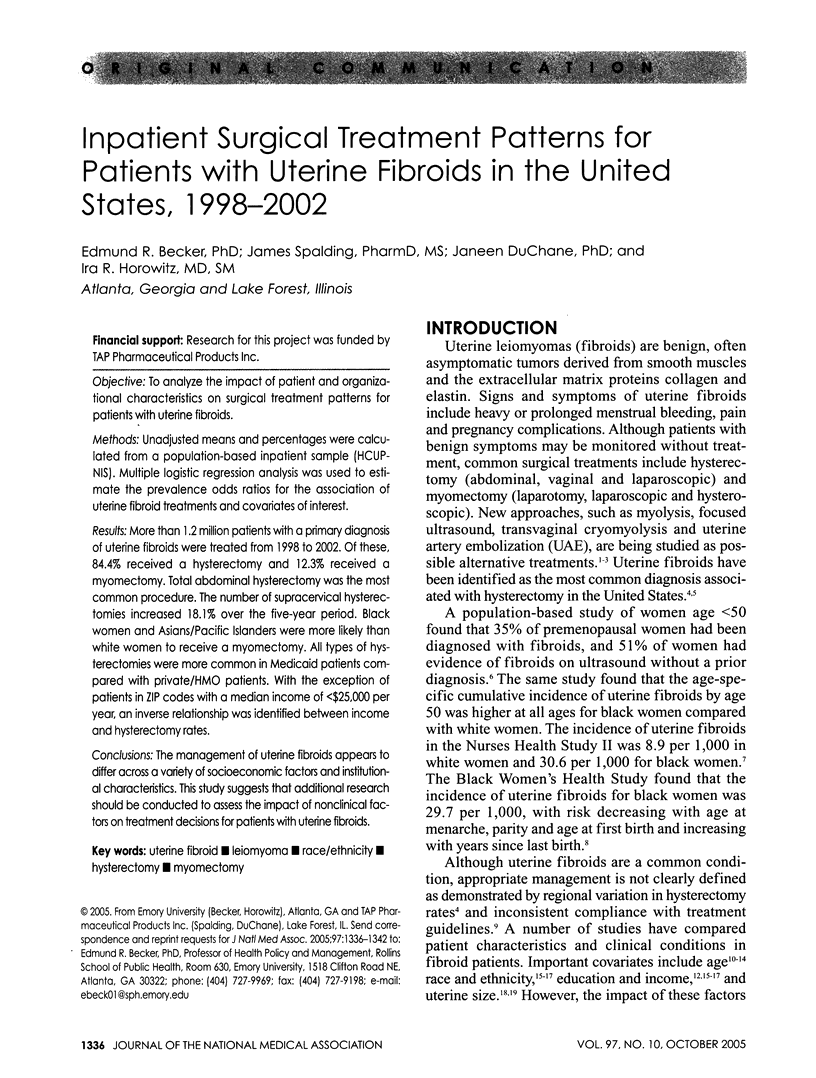
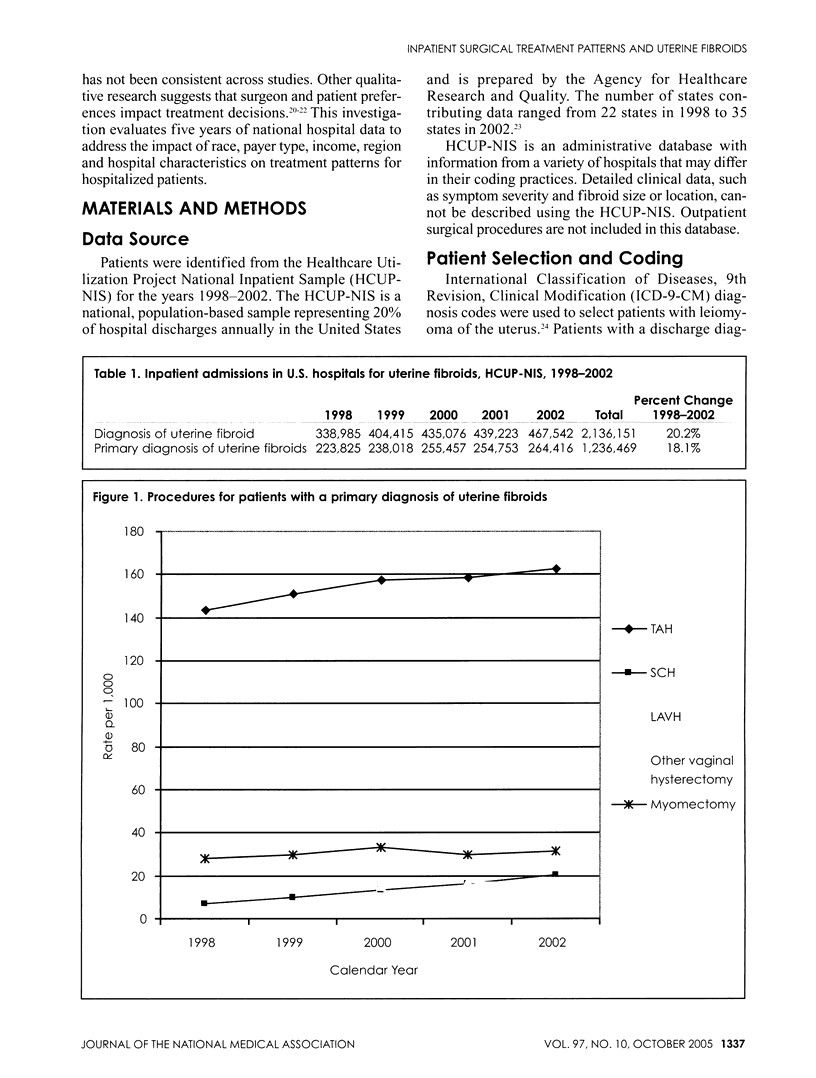


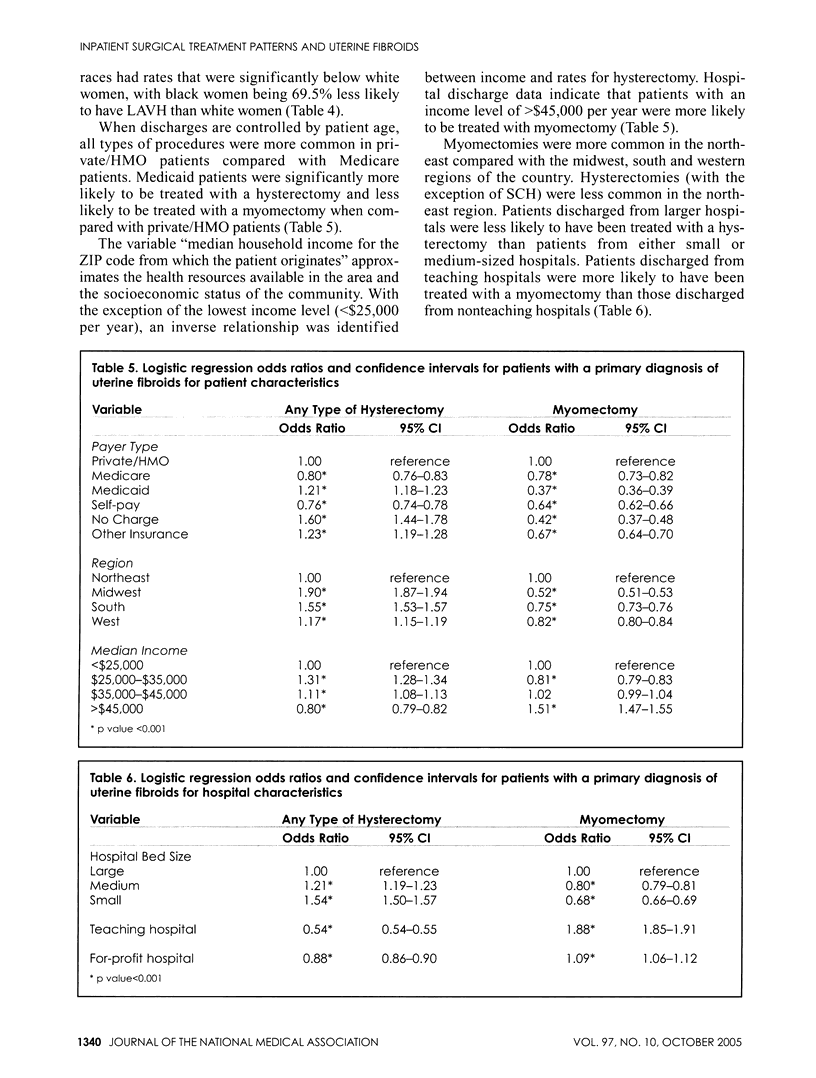
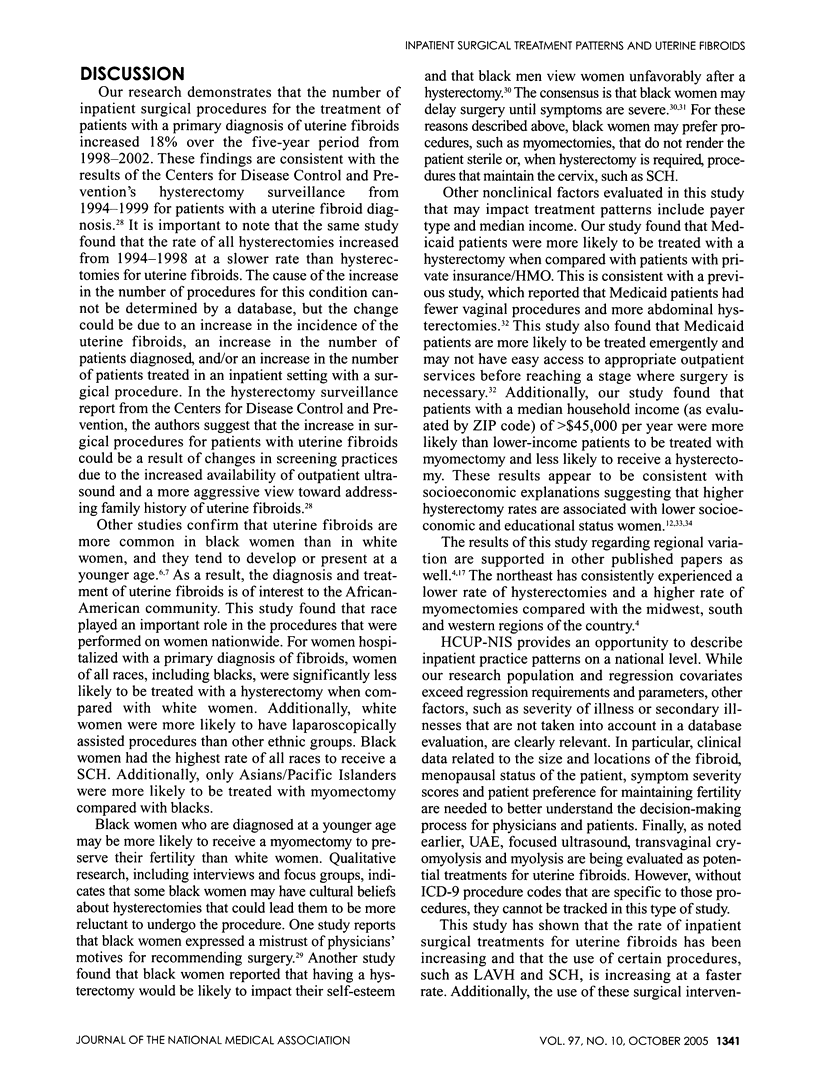
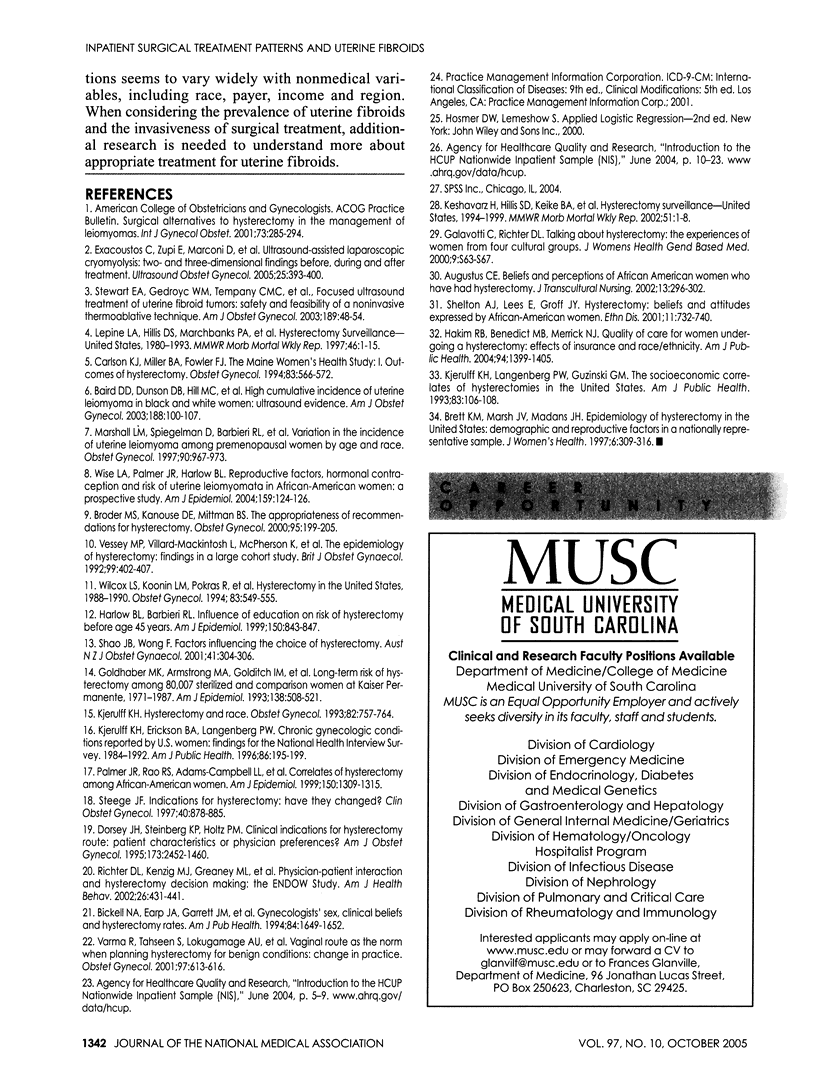
Selected References
These references are in PubMed. This may not be the complete list of references from this article.
- Augustus Cheryl E. Beliefs and perceptions of African American women who have had hysterectomy. J Transcult Nurs. 2002 Oct;13(4):296–302. doi: 10.1177/104365902236704. [DOI] [PubMed] [Google Scholar]
- Baird Donna Day, Dunson David B., Hill Michael C., Cousins Deborah, Schectman Joel M. High cumulative incidence of uterine leiomyoma in black and white women: ultrasound evidence. Am J Obstet Gynecol. 2003 Jan;188(1):100–107. doi: 10.1067/mob.2003.99. [DOI] [PubMed] [Google Scholar]
- Baird Donna Day. Invited commentary: uterine leiomyomata-we know so little but could learn so much. Am J Epidemiol. 2004 Jan 15;159(2):124–126. doi: 10.1093/aje/kwh017. [DOI] [PubMed] [Google Scholar]
- Bickell N. A., Earp J. A., Garrett J. M., Evans A. T. Gynecologists' sex, clinical beliefs, and hysterectomy rates. Am J Public Health. 1994 Oct;84(10):1649–1652. doi: 10.2105/ajph.84.10.1649. [DOI] [PMC free article] [PubMed] [Google Scholar]
- Brett K. M., Marsh J. V., Madans J. H. Epidemiology of hysterectomy in the United States: demographic and reproductive factors in a nationally representative sample. J Womens Health. 1997 Jun;6(3):309–316. doi: 10.1089/jwh.1997.6.309. [DOI] [PubMed] [Google Scholar]
- Broder M. S., Kanouse D. E., Mittman B. S., Bernstein S. J. The appropriateness of recommendations for hysterectomy. Obstet Gynecol. 2000 Feb;95(2):199–205. doi: 10.1016/s0029-7844(99)00519-0. [DOI] [PubMed] [Google Scholar]
- Carlson K. J., Miller B. A., Fowler F. J., Jr The Maine Women's Health Study: II. Outcomes of nonsurgical management of leiomyomas, abnormal bleeding, and chronic pelvic pain. Obstet Gynecol. 1994 Apr;83(4):566–572. doi: 10.1097/00006250-199404000-00013. [DOI] [PubMed] [Google Scholar]
- Dorsey J. H., Steinberg E. P., Holtz P. M. Clinical indications for hysterectomy route: patient characteristics or physician preference? Am J Obstet Gynecol. 1995 Nov;173(5):1452–1460. doi: 10.1016/0002-9378(95)90632-0. [DOI] [PubMed] [Google Scholar]
- Exacoustos C., Zupi E., Marconi D., Romanini M. E., Szabolcs B., Piredda A., Arduini D. Ultrasound-assisted laparoscopic cryomyolysis: two- and three-dimensional findings before, during and after treatment. Ultrasound Obstet Gynecol. 2005 Apr;25(4):393–400. doi: 10.1002/uog.1861. [DOI] [PubMed] [Google Scholar]
- Galavotti C., Richter D. L. Talking about hysterectomy: the experiences of women from four cultural groups. J Womens Health Gend Based Med. 2000;9 (Suppl 2):S63–S67. doi: 10.1089/152460900318777. [DOI] [PubMed] [Google Scholar]
- Goldhaber M. K., Armstrong M. A., Golditch I. M., Sheehe P. R., Petitti D. B., Friedman G. D. Long-term risk of hysterectomy among 80,007 sterilized and comparison women at Kaiser Permanente, 1971-1987. Am J Epidemiol. 1993 Oct 1;138(7):508–521. doi: 10.1093/oxfordjournals.aje.a116885. [DOI] [PubMed] [Google Scholar]
- Hakim Rosemarie B., Benedict M. Beth, Merrick Nancy J. Quality of care for women undergoing a hysterectomy: effects of insurance and race/ethnicity. Am J Public Health. 2004 Aug;94(8):1399–1405. doi: 10.2105/ajph.94.8.1399. [DOI] [PMC free article] [PubMed] [Google Scholar]
- Harlow B. L., Barbieri R. L. Influence of education on risk of hysterectomy before age 45 years. Am J Epidemiol. 1999 Oct 15;150(8):843–847. doi: 10.1093/oxfordjournals.aje.a010089. [DOI] [PubMed] [Google Scholar]
- Kjerulff K. H., Erickson B. A., Langenberg P. W. Chronic gynecological conditions reported by US women: findings from the National Health Interview Survey, 1984 to 1992. Am J Public Health. 1996 Feb;86(2):195–199. doi: 10.2105/ajph.86.2.195. [DOI] [PMC free article] [PubMed] [Google Scholar]
- Kjerulff K. H., Guzinski G. M., Langenberg P. W., Stolley P. D., Moye N. E., Kazandjian V. A. Hysterectomy and race. Obstet Gynecol. 1993 Nov;82(5):757–764. [PubMed] [Google Scholar]
- Kjerulff K., Langenberg P., Guzinski G. The socioeconomic correlates of hysterectomies in the United States. Am J Public Health. 1993 Jan;83(1):106–108. doi: 10.2105/ajph.83.1.106. [DOI] [PMC free article] [PubMed] [Google Scholar]
- Lepine L. A., Hillis S. D., Marchbanks P. A., Koonin L. M., Morrow B., Kieke B. A., Wilcox L. S. Hysterectomy surveillance--United States, 1980-1993. MMWR CDC Surveill Summ. 1997 Aug 8;46(4):1–15. [PubMed] [Google Scholar]
- Marshall L. M., Spiegelman D., Barbieri R. L., Goldman M. B., Manson J. E., Colditz G. A., Willett W. C., Hunter D. J. Variation in the incidence of uterine leiomyoma among premenopausal women by age and race. Obstet Gynecol. 1997 Dec;90(6):967–973. doi: 10.1016/s0029-7844(97)00534-6. [DOI] [PubMed] [Google Scholar]
- Palmer J. R., Rao R. S., Adams-Campbell L. L., Rosenberg L. Correlates of hysterectomy among African-American women. Am J Epidemiol. 1999 Dec 15;150(12):1309–1315. doi: 10.1093/oxfordjournals.aje.a009962. [DOI] [PubMed] [Google Scholar]
- Richter Donna L., Kenzig Melissa J., Greaney Mary L., McKeown Robert E., Saunders Ruth P., Corwin Sara J. Physician-patient interaction and hysterectomy decision making: the ENDOW study. Ethnicity, Needs, and Decisions of Women. Am J Health Behav. 2002 Nov-Dec;26(6):431–441. doi: 10.5993/ajhb.26.6.4. [DOI] [PubMed] [Google Scholar]
- Shao J. B., Wong F. Factors influencing the choice of hysterectomy. Aust N Z J Obstet Gynaecol. 2001 Aug;41(3):303–306. doi: 10.1111/j.1479-828x.2001.tb01232.x. [DOI] [PubMed] [Google Scholar]
- Shelton A. J., Lees E., Groff J. Y. Hysterectomy: beliefs and attitudes expressed by African-American women. Ethn Dis. 2001 Fall;11(4):732–740. [PubMed] [Google Scholar]
- Steege J. F. Indications for hysterectomy: have they changed? Clin Obstet Gynecol. 1997 Dec;40(4):878–885. doi: 10.1097/00003081-199712000-00023. [DOI] [PubMed] [Google Scholar]
- Stewart Elizabeth A., Gedroyc Wladyslaw M. W., Tempany Clare M. C., Quade Bradley J., Inbar Yael, Ehrenstein Tilman, Shushan Asher, Hindley Jonathan T., Goldin Robert D., David Matthias. Focused ultrasound treatment of uterine fibroid tumors: safety and feasibility of a noninvasive thermoablative technique. Am J Obstet Gynecol. 2003 Jul;189(1):48–54. doi: 10.1067/mob.2003.345. [DOI] [PubMed] [Google Scholar]
- Varma R., Tahseen S., Lokugamage A. U., Kunde D. Vaginal route as the norm when planning hysterectomy for benign conditions: change in practice. Obstet Gynecol. 2001 Apr;97(4):613–616. doi: 10.1016/s0029-7844(00)01232-1. [DOI] [PubMed] [Google Scholar]
- Vessey M. P., Villard-Mackintosh L., McPherson K., Coulter A., Yeates D. The epidemiology of hysterectomy: findings in a large cohort study. Br J Obstet Gynaecol. 1992 May;99(5):402–407. doi: 10.1111/j.1471-0528.1992.tb13758.x. [DOI] [PubMed] [Google Scholar]
- Wilcox L. S., Koonin L. M., Pokras R., Strauss L. T., Xia Z., Peterson H. B. Hysterectomy in the United States, 1988-1990. Obstet Gynecol. 1994 Apr;83(4):549–555. doi: 10.1097/00006250-199404000-00011. [DOI] [PubMed] [Google Scholar]


